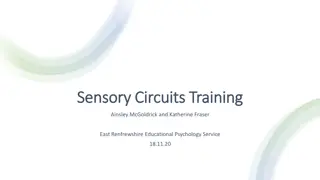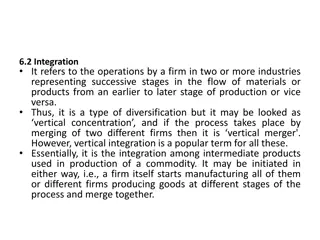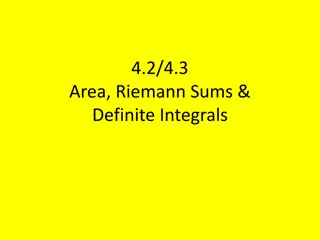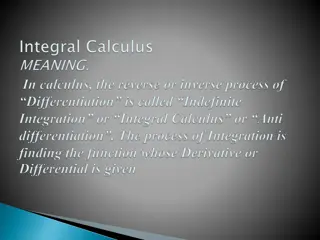Understanding Integration and Antiderivatives
Exploring the concepts of definite and indefinite integrals, Riemann sums, and antiderivatives in calculus. Learn about interpreting the definite integral, Riemann sums as rectangles approximating integrals, and finding general antiderivatives. Discover various formulas for finding antiderivatives of functions like ax, sin x, and more.
Download Presentation

Please find below an Image/Link to download the presentation.
The content on the website is provided AS IS for your information and personal use only. It may not be sold, licensed, or shared on other websites without obtaining consent from the author. Download presentation by click this link. If you encounter any issues during the download, it is possible that the publisher has removed the file from their server.
E N D
Presentation Transcript
First lets talk about what the integral means! Can you list some interpretations of the definite integral? b ( ) f x dx a
Heres a few facts: b ( ) f x dx 1. If f(x) > 0, then numerical value of the area between f(x) and the x-axis (area under the curve) a returns the a b = F(b) F(a) where F(x) is dx x f ) ( 2. any anti-derivative of f(x). (Fundamental Theorem of Calculus) a b 3. Basically gives the total cumulative dx x f ) ( change in f(x) over the interval [a,b]
What is a Riemann Sum? Hint: Here s a picture!
A Riemann sum is the area of n rectangles used to approximate the definite integral. = k 1 As n approaches infinity and = k 1 n = area of n rectangles ( ) f x x k k n b x dx ( ) ( ) f x f x k a So the definite integral sums infinitely many infinitely thin rectangles! (Calculus trivia: as n (number of rectangles) goes to the summation sign becomes the integral sign and x becomes dx)
The indefinite integral ( ) f x dx = ?
Wellhard to write; easy to say The indefinite integral equals the general antiderivative Where F (x) = f(x) ( ) f x dx = F(x) + C
+ 1 n nx 1 + xn dx = 1 + C
sin x dx Don t forget we are going backwards! So if the derivative was positive, the anti-derivative is negative. = - cos x + C cos x dx = sin x + C
1 dx = ln |x| +C x You need the absolute value in case x<0
1 dx where n > 1 xn Hint:
1/xn = x-n sooooooo . the answer is: + 1 n + C 1 + x 1 n You didn t say ln(xn) did ya??
Examples: dx 6 ( + ) 3 2 5 x x dx 3 x 4 dx ) 1 3 4 ( dx x 2+ 2 5 x dx dx +4 x 1 dx x























